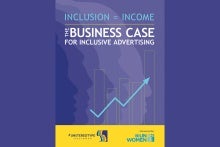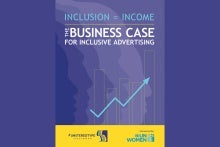New York, 17 September – The Unstereotype Alliance, an industry-led initiative convened by UN Women, today published a first-ever global study which empirically proves inclusive advertising -content which authentically and positively portrays a full range of people and is devoid of stereotypes -has a positive impact on business profit, sales and brand value.
The study was conducted with leading researchers from Saïd Business School at Oxford University, and leveraged proprietary data provided by Unstereotype Alliance members Bayer Consumer Healthcare, Diageo, the Geena Davis Institute, Kantar, Mars Incorporated, Mondelez International and Unilever.
The first-of-its-kind research, based on analysis of 392 brands across 58 countries, proves the positive impact of inclusive advertising on business outcomes in both the short- and long-term, and across multiple metrics. It highlights several areas of performance improvement including sales, financial performance, customer preference and loyalty, brand equity and market competitiveness. The findings confirm that inclusive ad campaigns deliver:
- 5% higher shorter-term sales and 16% higher longer-term sales
- 62% higher likelihood of being a consumer’s first choice
- 15% higher customer loyalty
The results further show this positive impact extends into the longer term, with a higher sales uptick, as well as brand perception and brand value metrics indicating a stronger and more robust brand reputation. The study covered different product categories, such as confectionary, snacks, personal care, beauty, pet food, pet care, alcohol, consumer healthcare, and household products, across geographies.
These findings challenge the assertion that inclusive advertising has an adverse effect on business performance, which has been used as an argument against inclusive practices and marketing communications, despite the lack of empirical backing or statistical evidence.
With the publication of the report, the Unstereotype Alliance is calling on the business community to adapt more inclusive advertising practices, and strongly endorses corporate efforts in this area. The findings highlight the commercial benefits from inclusive advertising and therefore supports the notion that inclusion should be considered a key element of overall corporate strategy and associated communications strategies.
Sara Denby, Head of the Unstereotype Alliance Secretariat at UN Women commented: “The idea that that inclusive advertising content can commercially damage a business has limited progress for too long. The assertion is consistently unfounded – but we needed to provide evidence to the contrary. This irrefutable data should reassure any business and encourage brands to renew their commitment to inclusivity in all forms, to not only benefit the communities they serve, but to drive growth and financially prosper.”
Esi Eggleston Bracey, Chief Growth and Marketing Officer at Unilever, commented: “Unilever has led the charge in creating bold, unmissable advertising that is progressive, provocative, and inclusive for years, from our work with Dove, Rexona and LUX to name but a few key brands. For us, creating work that is inclusive of people with different lived experiences isn’t just the right thing to do, it is a business imperative that drives brand power and commercial results. This report highlights the undeniable business case for more diverse and inclusive marketing and will prove a powerful tool as the industry strives for even more progressive, impactful work moving forward.”
David Evendon-Challis Executive Board Member and Chief Scientific Officer Head of R&D, Bayer Consumer Health, commented:
“It is incredibly important to bring the whole organization on the journey to drive inclusive content. At Bayer Consumer Health we strive for creative excellence and storytelling that includes all, so we embedded tools like the Gender Unstereotype Metric, set new action standards to stop ads airing that underperformed and upskilled our teams with a capability building programme. This not only inspired our teams and partners but resulted in greater creativity and content that serves and represents our customers in their full diversity.”
Prof Andrew Stephen, L’Oréal Professor of Marketing, Deputy Dean for Faculty and Research, Director of the Oxford Future of Marketing Initiative, Oxford University Saïd Business School, commented: “It’s crucially important that the decisions we make in business and society are rooted in correct assumptions and scientifically proven facts, rather than anecdotal evidence and unproven truisms. We are very pleased to share the findings which emerged from this study and be able to provide reliable information on this contested topic, allowing businesses to reconsider the role of inclusion in their advertising practices. They can gain a lot from doing so.”
Notes to Editors
Methodology:
The purpose of the study was to scientifically test the hypothesis that inclusive advertising has a positive impact on a brand’s (a) commercial performance and (b) value. To do this a large dataset was compiled by the Saïd Business School at the University of Oxford and the Unstereotype Alliance with extensive support from its member organisations. Sales data was provided by the participating companies for their brands, either directly or via their measurement agencies (Kantar Worldpanel and Nielsen IQ) with the brands’ permission.
To measure the extent to which a brand’s advertising and marketing was inclusive in a given year, the Unstereotype Alliance’s Gender Unstereotype Metric (GUM) was primarily used. GUM has two versions, one for female and one for male. The Female GUM measures on a five-point scale the extent to which a piece of advertising is perceived by in-market consumers to present a “positive image of the female character(s) that sets a good example for others.” The male GUM asks the same but instead with respect to male characters. GUM is measured at the campaign level at the time of the campaign and with respect to the geographic market in which the campaign ran. For the purposes of the statistical analysis, for each year and market, the average of campaign-level GUM scores for each brand in the sample we used to arrive at a single index of inclusive advertising for each brand at a particular point in time (year) and in a particular place (geographic market).
Convened by UN Women, the Unstereotype Alliance applies a gender lens to all of its inclusion work because all characteristics and lived experiences of a person are impacted by their gender. However, the use of the Gender Unstereotype Metric does not limit definitions of inclusive advertising to gender alone. Kantar captures 65 different characteristics of the talent in an ad including age, ethnicity, skin tone, body type, sexual orientation, and personality characteristics, as well as the activity the talent is engaged in. Commonalities are deduced across the 65 characteristics to find key drivers of inclusion in the top 25% of ads scored using the Gender Unstereotype Metric.
Please download report here, to view the full information about methodology.
About the Unstereotype Alliance
The Unstereotype Alliance seeks to eradicate harmful stereotypes from advertising and media to help create a more equal world. Convened by UN Women, the Alliance collectively acts to empower people in all their diversity (including gender, race, class, age, ability, ethnicity, religion, sexual orientation and more) by using advertising as a force for good to drive positive change all over the world. Since the Unstereotype Alliance launched at Cannes in 2017, the global membership now stands at 240 companies, and 12 national chapters across five continents that tackle culturally-nuanced stereotypes on the ground (http://www.unstereotypealliance.org).

